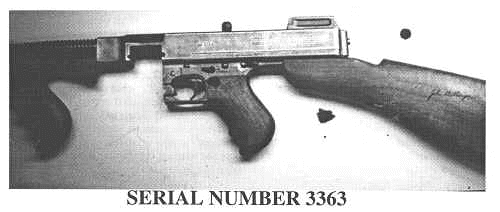| It appears that two Detectives
had been in Ace pool room on the square, less than a block south of the bank. A boy had
told the Detectives that there was a stick up at the bank. Det. Bergersen had reached the
corner building, the Wylie Hat Shop, when he was met by a burst of bullets from a machine
gun being fired through the window on the Fifth St side of the bank. Detective Bergersen
rushed into the hat shop seeking shelter only to find the entire front was a plate glass
cage down to the floor. The bullets splattered through the windows. Detective McEachon was
coming up and Bergersen shouted him to get back. Bergersen started crawling to the rear of
the shop. In the meantime McEachon had ran to the Venetian theater next door and went out
the rear into the alley where he was joined by, Bergersen. By this time the bandits with
their hostages had pushed and threatened their way through the crowd which had gathered in
front of the bank, walked along the side of the bank to their getaway can Earlier; the car
had been parked to the rear of the bank. As the two detectives reached the Fifth St end of
the alley, they were met by another burst of machine gun fire just as the bandits were
loading their hostages onto their getaway air.
Meanwhile, St Worsley had returned to the bank with more men including Lt. Muhlke who had armed himself with the other Thompson machine gun. They rounded the bank at Main and Fifth as the bandit's car was backing out. Lt. Muhlke could have fined at the car hut was waved off by bank president Weyland who was standing on the left running board with Mrs. Patzke while Officer Boyard was standing on the other side. The bandits had forced their hostages to stand on the running boards. With I)Dillinger at the wheel, they drove east to Lake, south on hike to Eight, west on Eight to Mead, north on Mead to Sixth and then west on Sixth headed out of the city. When they got to Sixth and LaFayette St, they halted and ordered Officer Boyard off of the running board and continued on their way making a clean getaway. Bank president Weyland and Mrs. Patzke were pulled into the car. Mrs. Patzke sat in the back with her feet on top of the machine guns and the stolen bags of money. Later they were tied to a tree in Waukesha County about 46 miles away. They released themselves after the bandits sped away. The leader was identified')'! the witnesses as well as the hostages as John Dillinger. During their ride with the bandits. Weyland and Patzke heard one of the other bandits being called "Mac" and this is believed to be Charles Makley. With the descriptions given by several witnesses and the police descriptions which tallied exactly with that of the members of the Indiana. Dillinger gang, District Attorney John Brown felt they had been identified to the point where he decided he would formally charge them with the crime. Warrants were sworn out for John Dillinger, linger; Harry Pierpont and Charles Makley. The Indiana State Police also sent photos of the five man Dillinger gang which included John Dillinger Harry Pierpont Russell Clark. Charles Makley and a man named Burns to help in the identification. Leslie Homer was later identified as one of the participants. He was arrested in Chicago a short time later, brought back to Racine, Wisconsin, found guilty for his part and sentenced to 28 years. On January 25, 1934, Dillinger was arrested with the other members of his gang in Tucson, Arizona. The Racine Police Department machine gun, serial number 3363, was among the guns found in possession of the bandits. While in the Tucson jail, a guard joked with Dillinger and talked him into signing his name in the wooden stock of the Thompson stolen from Racine Police. The Thompson was later returned to the Racine Police Dept with the signed stock. Years later the stock was considered valuable enough to take it out of service. The machine gun was left in service as the other Thompson that Racine Police had was not functioning leaving the recovered Thompson that Dillinger stole as the only one in service with the stock of the other Thompson on it. The last time the Dillinger Thompson was used in official police business was in the 1970s. It was then taken out of service and later put on display in the Racine Police Dept lobby.
NOTE: George V. Tresider
|
